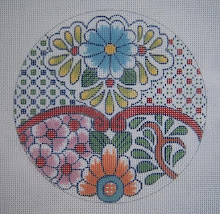 When I was a very small child, my great grandmother gave me a set of pillowcases that were edged with "fishnet" lace. The motif was a parade of little ducks, crocheted into the network in very fine threads, and I wish I had been wise enough to preserve this treasure! The love of and fascination with this type of needlework has never left me. It was the first kind I started "replicating" in needlepoint in the early 70's.
When I was a very small child, my great grandmother gave me a set of pillowcases that were edged with "fishnet" lace. The motif was a parade of little ducks, crocheted into the network in very fine threads, and I wish I had been wise enough to preserve this treasure! The love of and fascination with this type of needlework has never left me. It was the first kind I started "replicating" in needlepoint in the early 70's. The first illustration is a needlepoint pillow I made for my granddaughter Sophie, as I love the look of the crocheted filet. The motif is simple, and it moves quickly in the stitching - great borders, as well as lovely pillows may be made this way.
 Next - the pink one, is for our Julia. (truly a W.I.S.P., as I get distracted with other things to stitch).
Next - the pink one, is for our Julia. (truly a W.I.S.P., as I get distracted with other things to stitch). You can see how this is done, I think, simply by studying the pictures - click to enlarge. I like to use smyrna cross for the filled-in spaces of the design, and the background color within the body of the lace is mosaic stitch.
You can see how this is done, I think, simply by studying the pictures - click to enlarge. I like to use smyrna cross for the filled-in spaces of the design, and the background color within the body of the lace is mosaic stitch. I have thoroughly studied the history of lace, and encourage anyone to do it, as it's fascinating - but I won't go into it in depth here. There are Biblical references to "netting with linen," and early examples have been found from the year 2,500 B.C. This type of "filet lace" originated in Italy, where some of the very earliest laces were made - it originally evolved from a linen fabric from which threads were drawn to make a sort of grid or netting, into which embroidery stitches were placed (buttonhole) to make a lacy openwork. In the late 14th to early 15th century, the Reticella lace then became a "punto in aria" or "stitch in the air" type lace, rather than starting with a fabric and pulling or cutting the threads. It was this lace that the Irish imitated with their beautiful crochet - and it became "fishnet" lace, or "filet."

To make filet lace in needlepoint, a grid or "network" must be stitched - making the vertical lines first to avoid warping the canvas. This is the only time I have ever used graph paper for designing in needlepoint - but find it necessary - extremely simple! The little spaces are filled in with smyrna cross to create the pattern. Here are some very simple charts to explain the method: Also, I can fairly well figure the size of a motif - or whatever I need, by just marking lines, as each design space requires 3 threads.
 The very simple chart illustrates the tent stitches that make up the "netting," and the little green stitches illustrate Smyrna crosses to fill in for pattern. The hearts are designed to be small motifs - you can count the threads, adding two between each, to find the size. The green one is about 2" wide, or slightly more. The little blue one I visualized on 13 mesh, so it would be app.
The very simple chart illustrates the tent stitches that make up the "netting," and the little green stitches illustrate Smyrna crosses to fill in for pattern. The hearts are designed to be small motifs - you can count the threads, adding two between each, to find the size. The green one is about 2" wide, or slightly more. The little blue one I visualized on 13 mesh, so it would be app. 1 1/2" wide. I have found great sources for patterns for crocheted filet lace if you don't want to create your own. This site, Crochet.About.com has some really pretty ones that are free - I would make pillows with them!

Wowser! That is so intricate, so delcate looking, so lovely. That's not even in my "I'd like to try....." catagory. LOL
ReplyDelete